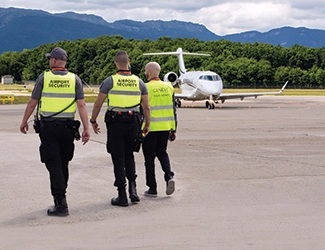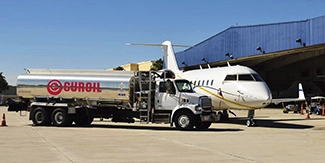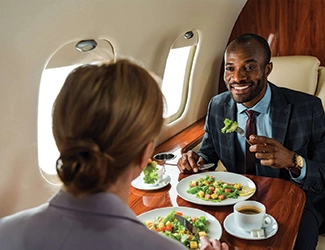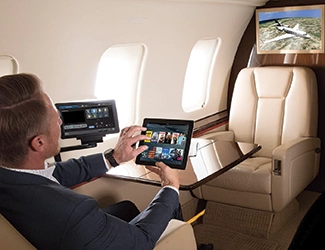Security considerations
What to consider when flying your business jet abroad.
By Shannon Forrest
ATP/CFII. Challenger 604, G-IV
Contributing Writer

Security is tough to quantify. Although there’s an objective component to it, security can be very subjective at the personal level. What’s perceived as a minor threat to one person may be interpreted as deleterious to another.
Maintaining a secure environment while one is stationary, as for example in one’s personal residence or business, is reasonably simple to accomplish. On the other hand, traveling presents a unique set of challenges that require advanced planning, constant attention to the operating environment, and sometimes last-minute changes to a previously developed agenda.
A major advantage of employing corporate and private aviation is that there’s an inherent security component built in. The act of avoiding close contact with the large numbers of passengers who travel by airline decreases exposure to risk exponentially.
This became especially evident during the Covid-19 pandemic, when traveling in small groups became the safest option. In addition, those who travel within the smaller, more intimate confines of a business jet cabin are typically known to each other and to the flight crew.
Resources within the US
When traveling domestically in the US, it seems the only limitation on security is budget. Within the continental US, a high-net-worth individual, celebrity, or star athlete can garner protection by staffing his/her private plane and vehicles with a cadre of ex-special forces tier-one operators who may carry an arsenal and employ a Belgian Malinois watchdog named Cujo.
The plethora of general aviation airports in the US enables private aircraft operators to get close to a destination without using major airports, making movement less likely to be detected. Further anonymity can be employed by blocking or obfuscating ADS-B Out data that’s used by FAA or provided to third-party aircraft tracking services. Operators can also enroll in the Limiting Aircraft Data Displayed (LADD) program with the goal of blocking aircraft tracking data from being disseminated through FAA data systems.

Identifying data not handled through FAA can be blocked using a Private ICAO Address or PIA code – a discrete ADS-B identifier that’s not tied to FAA civil aircraft registry. Using these techniques does not prevent ADS-B transmission, but it does obscure the name of the entity that owns the aircraft. Both LADD and PIA are requested through FAA.
Even in US cities with statistically high crime rates, FBOs tend to be safe havens, because someone is on duty all the time and doors and gates are typically locked. Suspicious activity is commonly detected and reported quickly to the TSA hotline, often by private or recreational pilots who just happen to be at the airport.
Within the US, information about security threats is easy to obtain, law enforcement is readily accessible, medical attention is not far away, and emergency egress can be achieved quickly.
International environment
Being abducted and held for ransom by a fringe political group while enjoying a complimentary cookie at the FBO counter – even at a border town airport like ELP (El Paso TX) – is extremely unlikely. But the same cannot be said of international destinations, where airports may be less numerous and aircraft are restricted to airports of entry if arriving from a foreign country. This means there are fewer options for avoiding undesirable locales.
Although the US is not immune from political discord, such dissent doesn’t usually escalate to violent incidents common in some other countries. The events currently taking place in Haiti serve as an example of how flight crews can be affected by localized violence.
In Nov 2024, a Spirit Airlines flight was hit by gunfire while on final approach to PAP (Port-au-Prince, Haiti). One flight attendant suffered minor injuries, and the flight was diverted to the Dominican Republic. An investigation later revealed that 2 other aircraft operated by American Airlines and JetBlue also had damage consistent with firearms.
Establishing a security protocol
Bizjet operators traveling overseas need to assess the level of risk at their intended destination. This is a function of who owns the aircraft (corporation or individual), who’s on the aircraft, and where the aircraft is going. There exists a vast disparity in threats between countries traditionally considered friendly to US interests (eg, France, Germany, and the UK) and those in regions less apt to maintain congenial relationships (eg, South America, Africa, and the Middle East).

However, things can change rapidly, especially with recent shifts in the political paradigm in the US. The recent application of near-universal tariffs by the Trump administration has caused some discord in the international community, and this has not gone unnoticed by citizens who feel they’re being wronged by the policy.
It’s almost universally known that an aircraft with an “N” number is registered in the US, and residents of poorer countries equate the use of private jets with the ruling class and US capitalism at large. Business jets may be seen as tokens of power, which thus represent targets of opportunity to make a political point.
Climate activism is a nascent form of protest that attempts to disrupt operations which proponents of the cause feel are harmful to the environment. The biggest targets are private jets and yachts that are perceived to produce a large carbon footprint. Unlike political protests, which tend to appear in poorer countries, climate activism is popping up in more developed areas of the world, like Western Europe and Canada.
Many resources are available to assess the risk level for specific regions of the world. Planning services like Universal or ARINCDirect can incorporate security assessments into dispatch packages provided to flight crews. Planning services can also provide handlers at the destination to deal with specifics.
Pilots who desire a more in-depth analysis of what’s going on have a couple of places to turn to. The US Department of State website provides advice on whether to travel to or avoid travel to international destinations. The CIA World Factbook (also available online) is a country-specific resource that describes everything from monetary policy to political environment.
The Diplomatic Security Service website incorporates US Department of State travel guidance into country-specific security reports. Major sections of the report cover crime, kidnapping threat, terrorism, political violence and civil unrest, political stability, protests and demonstrations, and law enforcement. These reports are thorough. For example, a recent 5-page assessment of GEO (Georgetown, Guyana) described the crime threat as critical, terrorism threat low, and the chance of political violence as medium. Collectively, these factors can determine benefit versus risk of a particular trip.
Risk mitigation
Risk mitigation can be divided into 3 components – what goes on it, what goes in it, and what passes through it.
What goes on starts with the crew and passengers. Crew is most likely handled at the corporate level via background and identification checks. Every passenger is different when it comes to risk profile and level of personal protection required upon arrival at an international destination.

Large US corporations commonly employ security detachments to handle movement of executives once they leave the aircraft. Similarly, smaller flight departments or single-aircraft operations contract with local security once on the ground.
International firearms laws (for those outside of law enforcement or the military) can vary widely from those of the US, which complicates matters for those accustomed to traveling with armed escorts.
Anonymity is a simple form of security to protect high-profile passengers, and it’s one that’s most often violated. It’s hard to be a target if no one knows you’re there. Social media have given rise to a new method of surveillance called open-source intelligence (OSINT).
The amount of personal information that can be obtained freely from sources like Facebook, Instagram, YouTube, and Tik-Tok is staggering. By combining online information from multiple sources and the FAA pilot registry (for pilots who have not blocked their publicly available home address), it’s possible to piece together who a pilot works for and who he’s likely transporting.
However, this trend of documenting one’s daily life on social media platforms is largely a generational issue. Older pilots seem content with going about their daily lives without posting pictures of their dinner, their hotel room, or the fact that they left home on a trip, for how long, and where to.
The number one thing that goes in the aircraft – and that every aircraft needs – is fuel. The underlying goal of security is to protect the aircraft occupants. Avoiding a flame-out because of fuel contamination should be a priority. Although human error is the most likely culprit in fuel contamination incidents, nefarious purposes can’t be ruled out.
Using a well-established branded company with US and global-based operations, that maintains strict standards and a rigorous training program for fuelers, is one line of defense. Avfuel, for example, is a global supplier of aviation fuel and FBO services. The company also offers a proprietary trip support program known as Avplan, which works with schedulers and dispatchers to find reliable fuel in specific locations. Some international locations present complex challenges regarding fuel availability and quality, and Avfuel can assist with such logistics.
Another item that goes in the aircraft – and one not often considered – is catering and crew meals. Anyone who’s had food poisoning while on a trip knows how bad it can be. Having agonizing stomach pain halfway across the Atlantic is detrimental to flight safety – as is spending most of the time in the aircraft lav.
Just like fuel, most of the contaminated food is probably the result of poor handling practices. In foreign countries, sanitation practices differ widely from those of the US. In addition, it can be hard to determine whether food has been held at a safe temperature prior to reaching the aircraft.
When considering the overall security picture, catering and crew meals present an opportunity to introduce a security breach to the aircraft, whether intentionally or otherwise. To reduce this risk, some flight departments have gotten creative by bringing raw ingredients with them from home base and creating meals on the aircraft. Others source ingredients internationally, but do so outside the confines of the FBO, so that it’s not apparent the food is going to a US-registered aircraft.
Finally, what passes through the aircraft is a host of personal and corporate data. Cyber attacks have gotten more sophisticated, so airborne Wi-Fi networks operating within the aircraft can be a potential target when in range of interception (for instance, while sitting on the FBO ramp or taxiing). Protection from cyber attacks starts with a quality router.
One of the premier devices is manufactured by Satcom Direct – now owned by Gogo. The SDR router supports L, Ku, Ka, and X band satellite transmission, as well as the typical ATG cellular network. Multiple secure Wi-Fi networks support VIP and guest networks. Gogo offers a threat monitoring and risk mitigation service that uses algorithms to detect breaches within the aircraft network. A dedicated team is available 24/7 to contain and repair any cyber-related attack before it disrupts operations.
Final recommendations
At its most basic level, international security resembles what has become a best practice in the US. Lock the aircraft. Use security tape or similar mechanisms to detect unauthorized access when not at home base. If possible, store the aircraft in a hangar. Remember to turn on aircraft alarm systems, if installed. Maintain situational awareness when dealing with those outside the flight department.
What’s not so easy at international destinations is the process of extraction if something goes awry, whether it’s security related or a medical emergency. That’s when a company that can provide quick resources and rapid evacuation (like MedAire or Global Rescue) can be invaluable.
Ultimately, it’s important to trust instincts during a potential security threat. As described in the book The Gift of Fear by security expert Gavin de Becker, if things don’t feel right, they’re probably not. The best way to handle a security breach is to not be there to begin with.
 Shannon Forrest is a current line pilot, CRM facilitator, and aviation safety consultant. He has more than 15,000 hrs TT and holds a degree in behavioral psychology.
Shannon Forrest is a current line pilot, CRM facilitator, and aviation safety consultant. He has more than 15,000 hrs TT and holds a degree in behavioral psychology.